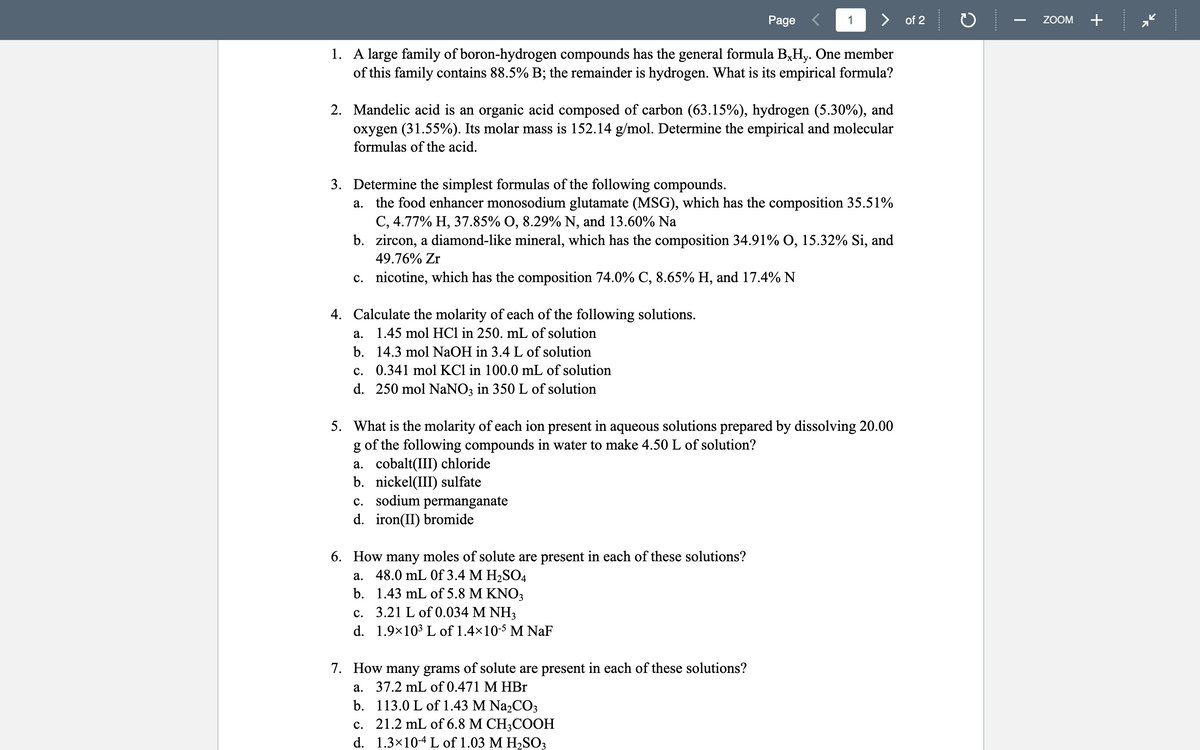Page > of 2 1. A large family of boron-hydrogen compounds has the general formula B,H,. One member of this family contains 88.5% B; the remainder is hydrogen. What is its empirical formula?
Page > of 2 1. A large family of boron-hydrogen compounds has the general formula B,H,. One member of this family contains 88.5% B; the remainder is hydrogen. What is its empirical formula?
Chemistry
10th Edition
ISBN:9781305957404
Author:Steven S. Zumdahl, Susan A. Zumdahl, Donald J. DeCoste
Publisher:Steven S. Zumdahl, Susan A. Zumdahl, Donald J. DeCoste
Chapter1: Chemical Foundations
Section: Chapter Questions
Problem 1RQ: Define and explain the differences between the following terms. a. law and theory b. theory and...
Related questions
Question

Transcribed Image Text:Page <
of 2
+
ZOOM
1. A large family of boron-hydrogen compounds has the general formula B,Hy. One member
of this family contains 88.5% B; the remainder is hydrogen. What is its empirical formula?
2. Mandelic acid is an organic acid composed of carbon (63.15%), hydrogen (5.30%), and
oxygen (31.55%). Its molar mass is 152.14 g/mol. Determine the empirical and molecular
formulas of the acid.
3. Determine the simplest formulas of the following compounds.
a. the food enhancer monosodium glutamate (MSG), which has the composition 35.51%
C, 4.77% H, 37.85% O, 8.29% N, and 13.60% Na
b. zircon, a diamond-like mineral, which has the composition 34.91% O, 15.32% Si, and
49.76% Zr
c. nicotine, which has the composition 74.0% C, 8.65% H, and 17.4% N
4. Calculate the molarity of each of the following solutions.
а.
1.45 mol HCl in 250. mL of solution
b. 14.3 mol NAOH in 3.4 L of solution
c. 0.341 mol KCl in 100.0 mL of solution
d. 250 mol NaNO3 in 350 L of solution
5. What is the molarity of each ion present in aqueous solutions prepared by dissolving 20.00
g of the following compounds in water to make 4.50 L of solution?
a. cobalt(III) chloride
b. nickel(III) sulfate
c. sodium permanganate
d. iron(II) bromide
6. How many moles of solute are present in each of these solutions?
a. 48.0 mL 0f 3.4 M H2SO4
b. 1.43 mL of 5.8 M KNO3
c. 3.21 L of 0.034 M NH3
d. 1.9x103 L of 1.4x10-5 M NaF
7. How many grams of solute are present in each of these solutions?
a. 37.2 mL of 0.471 M HBr
b. 113.0 L of 1.43 M Na2CO3
c. 21.2 mL of 6.8 M CH3COOH
d. 1.3×104 L of 1.03 M H2SO3
Expert Solution
This question has been solved!
Explore an expertly crafted, step-by-step solution for a thorough understanding of key concepts.
This is a popular solution!
Trending now
This is a popular solution!
Step by step
Solved in 3 steps with 2 images

Knowledge Booster
Learn more about
Need a deep-dive on the concept behind this application? Look no further. Learn more about this topic, chemistry and related others by exploring similar questions and additional content below.Recommended textbooks for you

Chemistry
Chemistry
ISBN:
9781305957404
Author:
Steven S. Zumdahl, Susan A. Zumdahl, Donald J. DeCoste
Publisher:
Cengage Learning

Chemistry
Chemistry
ISBN:
9781259911156
Author:
Raymond Chang Dr., Jason Overby Professor
Publisher:
McGraw-Hill Education

Principles of Instrumental Analysis
Chemistry
ISBN:
9781305577213
Author:
Douglas A. Skoog, F. James Holler, Stanley R. Crouch
Publisher:
Cengage Learning

Chemistry
Chemistry
ISBN:
9781305957404
Author:
Steven S. Zumdahl, Susan A. Zumdahl, Donald J. DeCoste
Publisher:
Cengage Learning

Chemistry
Chemistry
ISBN:
9781259911156
Author:
Raymond Chang Dr., Jason Overby Professor
Publisher:
McGraw-Hill Education

Principles of Instrumental Analysis
Chemistry
ISBN:
9781305577213
Author:
Douglas A. Skoog, F. James Holler, Stanley R. Crouch
Publisher:
Cengage Learning

Organic Chemistry
Chemistry
ISBN:
9780078021558
Author:
Janice Gorzynski Smith Dr.
Publisher:
McGraw-Hill Education

Chemistry: Principles and Reactions
Chemistry
ISBN:
9781305079373
Author:
William L. Masterton, Cecile N. Hurley
Publisher:
Cengage Learning

Elementary Principles of Chemical Processes, Bind…
Chemistry
ISBN:
9781118431221
Author:
Richard M. Felder, Ronald W. Rousseau, Lisa G. Bullard
Publisher:
WILEY